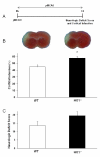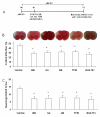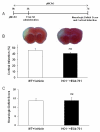Heme oxygenase 1, beneficial role in permanent ischemic stroke and in Gingko biloba (EGb 761) neuroprotection
- PMID: 21334424
- PMCID: PMC3070771
- DOI: 10.1016/j.neuroscience.2011.02.031
Heme oxygenase 1, beneficial role in permanent ischemic stroke and in Gingko biloba (EGb 761) neuroprotection
Abstract
Ginkgo biloba extract, EGb 761, a popular and standardized natural extract, contains 24% ginkgo-flavonol glycosides and 6% terpene lactones. EGb 761 is used worldwide to treat many ailments, and although a number of studies have shown its neuroprotective properties, the mechanisms of action have not been elucidated fully. We hypothesize that EGb 761 and some of its bioactive components [Bilobalide (BB), Ginkgolide A (GA), Ginkgolide B (GB), and Terpene Free Material (TFM)] could provide neuroprotection in ischemic conditions through heme oxygenase 1 (HO1). Mice were subjected to permanent distal middle cerebral artery occlusion (pMCAO) and survived for 7 days. HO1 knockout (HO1⁻/⁻) mice showed significantly higher (P<0.05) infarct volume and Neurologic Deficit Scores (NDS) as compared to their wildtype (WT) counterparts. In another cohort, WT mice subjected to pMCAO and treated at 4 h of pMCAO with 100 mg/kg EGb 761, 6 mg/kg BB, GA, GB, or 10 mg/kg TFM showed significantly lower (P<0.05) infarct volumes (BB; 29.0±3.9%, GA; 31.3±4.0%, GB; 32.0±3.8%, TFM; 32.5±3.5%, and EGb 761; 27.4±4.5%) than those in the vehicle-treated mice (46.0±3.7%). Similarly, NDS were lower in BB; 7.1±1.8, GA; 7.4±2.1, GB; 7.9±1.8, TFM; 7.7±1.7, and EGb 761; 6.8±2.0 groups as compared with the vehicle-treated group (13.8±1.5). Interestingly, the protective effect of EGb 761 was essentially lost when HO1 knockout mice were treated with EGb 761. In another cohort, HO1, vascular endothelial growth factor (VEGF) and endothelial nitric oxide synthase (eNOS) protein levels in the brain cortices appeared to be higher in EGb 761 and BB but not in GA, GB and TFM treated groups. Together, these results suggest that HO1 plays, at least in part, an important role in the neuroprotective mechanism of EGb 761 and in delayed ischemia. Targeting this pathway could lead to neuroprotective agents against ischemic stroke.
Copyright © 2011 IBRO. Published by Elsevier Ltd. All rights reserved.
Figures





References
-
- Ahmad AS, Zhuang H, Doré S. Heme oxygenase-1 protects brain from acute excitotoxicity. Neuroscience. 2006;141:1703–1708. - PubMed
-
- Alaoui-Youssefi A, Lamproglou I, Drieu K, Emerit I. Anticlastogenic effects of Ginkgo biloba extract (EGb 761) and some of its constituents in irradiated rats. Mutat Res. 1999;445:99–104. - PubMed
- Barth SA, Inselmann G, Engemann R, Heidemann HT. Influences of Ginkgo biloba on cyclosporin A induced lipid peroxidation in human liver microsomes in comparison to vitamin E, glutathione and N-acetylcysteine. Biochem Pharmacol. 1991;41:1521–1526. - PubMed
-
- Bastianetto S, Ramassamy C, Doré S, Christen Y, Poirier J, Quirion R. The Ginkgo biloba extract (EGb 761) protects hippocampal neurons against cell death induced by beta-amyloid. Eur J Neurosci. 2000;12:1882–1890. - PubMed
-
- Boettler U, Sommerfeld K, Volz N, Pahlke G, Teller N, Somoza V, Lang R, Hofmann T, Marko D. Coffee constituents as modulators of Nrf2 nuclear translocation and ARE (EpRE)-dependent gene expression. J Nutr Biochem. 2010 - PubMed
-
- Chan PC, Xia Q, Fu PP. Ginkgo biloba leave extract: biological, medicinal, and toxicological effects. J Environ Sci Health C Environ Carcinog Ecotoxicol Rev. 2007;25:211–244. - PubMed
Publication types
MeSH terms
Substances
Grants and funding
LinkOut - more resources
Full Text Sources
Medical
Molecular Biology Databases

